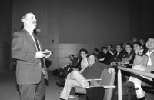Killian Award winner Robert A.Weinberg showed unflagging good humor last Wednesday in the face of what he called "the lecturer's worst nightmare" -- a jammed slide projector and a slew of mixed-up slides.
"It's time for jokes," said Dr. Weinberg, who has received numerous honors for his research, including the National Medal of Science in 1997. Even though he was giving what some might consider MIT's most prestigious campus lecture to a standing-room-only crowd, he managed to keep his audience laughing at the technical difficulties as well as impress them with his scientific acumen. "I've lectured in places that don't even have electricity, so this is nothing," he quipped.
Dr. Weinberg, the Daniel K. Ludwig Professor for Cancer Research and American Cancer Society Professor of Biology, is one of the country's most eminent cell biologists. As the winner of the prestigious James R. Killian Jr. Faculty Achievement Award, announced last June, he delivered the Killian lecture, "Genes and the Origins of Human Cancer," to the MIT community this spring.
WHEN GOOD CELLS GO BAD
One of the founding members of the Whitehead Institute for Biomedical Research, Professor Weinberg described his ongoing struggle to uncover how a normal cell is converted into a tumor cell.
At times, it seemed like the cancer cells were winning the struggle. Professor Weinberg said the first step toward understanding came around 200 years ago when people began to have inklings that tumors, rather than being random acts of nature, were caused by something.
One of the first "epidemiological" looks at the disease occurred around 1800 when it was noticed that chimney sweeps in Britain had unusually high rates of scrotal cancer.
When strides were made years later in genetics, that knowledge took cancer research to a new level. In 1978, Professor Weinberg's lab tried to find mutant genes in cancer cells. The researchers took DNA out of cancer cells and inserted it into normal cells, turning the normal cells into cancer cells. The next step was to identify the specific gene -- the oncogene -- that could do this.
They tracked the culprit to a single switched base -- the equivalent of one grain of sand in a hill of genetic material. This switch turns out to be instrumental in about a quarter of human tumors, but the picture was not anywhere close to being complete.
While this oncogene caused cells to proliferate out of control, it turned out that there were other mechanisms that caused cells to lose their ability to know when to stop multiplying. "Both mechanisms conspire to create the runaway cell," Professor Weinberg said.
The third part of the puzzle centered around cancer cells' ability to proliferate forever while normal cells double a certain number of times and then die. His lab found that the difference was because of telomeres, which are like little caps that protect the ends of genetic material similar to the plastic caps that keep the ends of shoelaces from unraveling.
Normal cells' telomeres become shorter after each cell division until they shrink to a certain size and then the cell dies. In contrast, cancer cells are able to "turn on" a gene that produces an enzyme called telomerase, which keeps telomeres from shrinking. This enzyme, Professor Weinberg said, is readily detectable in 90 percent of human tumors.
After decades of research and some major triumphs and many dead ends, "one can now begin to define all the regulatory events that must be disrupted to transform normal cells into malignant tumor cells," he said. It turns out to be what he calls a "holy trinity" of transformations: the gene that acts like an accelerator stuck to the floor, the gene that disables the braking system and the telomerase that immortalizes cells.
At least two puzzles remain: how do tumor cells convince nearby blood vessels to hook them up to the blood supply they need to grow and flourish, and how do they metastasize? "Ninety percent of cancer patients die from distant metastasis," Professor Weinberg said. "How do cancer cells learn to invade other parts of the body?"
TECHNICAL DIFFICULTIES
When Professor Weinberg, who earned a bachelor's degree from MIT in 1964 and a doctorate in 1969, was a few minutes into his talk, it became apparent that there was something wrong with the audiovisual system. Slides weren't showing up when they were supposed to.
While the crew worked to fix the jamming projector, members of the audience with a view of Wong Auditorium's control room could see some of Weinberg's carefully ordered slides bounce out of the slide tray.
"Lord save me," Dr. Weinberg said when he was told the slides were now hopelessly out of order. "Kill me on the spot. This is going to be extemporaneous." While he attempted to continue his lecture with a blank screen, he quipped, "As they say in California, 'You know what I mean.' You can imagine what this might look like," he said of one nonexistent slide.
At one point he said, "As my wife says, you stay here and chat and I'll fix it myself." He went to the control room, where he and the audiovisual crew finally corrected the problem.
Professor Weinberg is the recipient of the 28th Killian Award, established to "recognize extraordinary professional accomplishments by full-time members of the MIT faculty." The awardee is chosen by a faculty committee. It is the greatest honor the faculty can bestow on one of its members.
A version of this article appeared in MIT Tech Talk on March 15, 2000.






